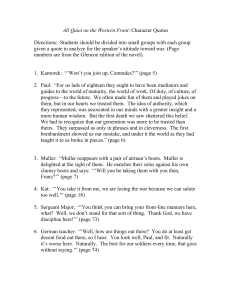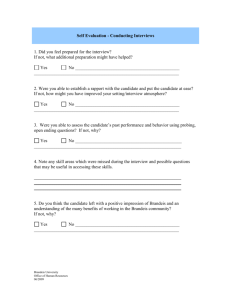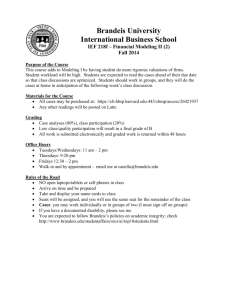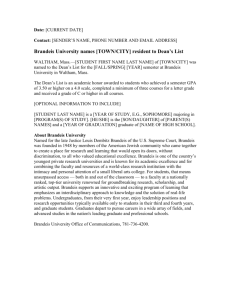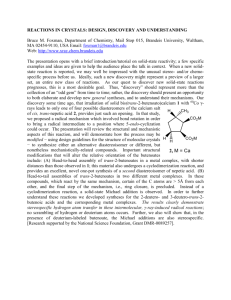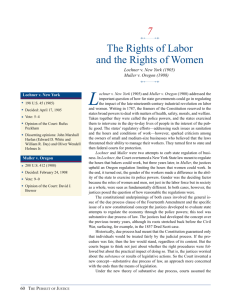Explanation of Louis Brandeis' work in Muller v. Oregon Appellant
advertisement
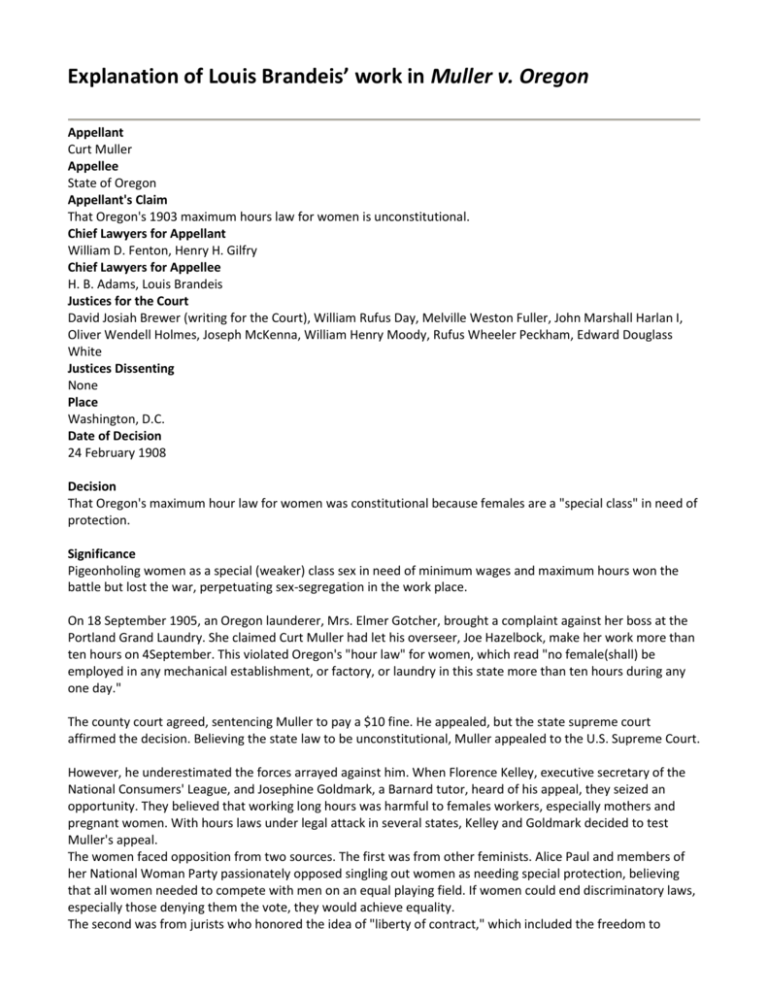
Explanation of Louis Brandeis’ work in Muller v. Oregon Appellant Curt Muller Appellee State of Oregon Appellant's Claim That Oregon's 1903 maximum hours law for women is unconstitutional. Chief Lawyers for Appellant William D. Fenton, Henry H. Gilfry Chief Lawyers for Appellee H. B. Adams, Louis Brandeis Justices for the Court David Josiah Brewer (writing for the Court), William Rufus Day, Melville Weston Fuller, John Marshall Harlan I, Oliver Wendell Holmes, Joseph McKenna, William Henry Moody, Rufus Wheeler Peckham, Edward Douglass White Justices Dissenting None Place Washington, D.C. Date of Decision 24 February 1908 Decision That Oregon's maximum hour law for women was constitutional because females are a "special class" in need of protection. Significance Pigeonholing women as a special (weaker) class sex in need of minimum wages and maximum hours won the battle but lost the war, perpetuating sex-segregation in the work place. On 18 September 1905, an Oregon launderer, Mrs. Elmer Gotcher, brought a complaint against her boss at the Portland Grand Laundry. She claimed Curt Muller had let his overseer, Joe Hazelbock, make her work more than ten hours on 4September. This violated Oregon's "hour law" for women, which read "no female(shall) be employed in any mechanical establishment, or factory, or laundry in this state more than ten hours during any one day." The county court agreed, sentencing Muller to pay a $10 fine. He appealed, but the state supreme court affirmed the decision. Believing the state law to be unconstitutional, Muller appealed to the U.S. Supreme Court. However, he underestimated the forces arrayed against him. When Florence Kelley, executive secretary of the National Consumers' League, and Josephine Goldmark, a Barnard tutor, heard of his appeal, they seized an opportunity. They believed that working long hours was harmful to females workers, especially mothers and pregnant women. With hours laws under legal attack in several states, Kelley and Goldmark decided to test Muller's appeal. The women faced opposition from two sources. The first was from other feminists. Alice Paul and members of her National Woman Party passionately opposed singling out women as needing special protection, believing that all women needed to compete with men on an equal playing field. If women could end discriminatory laws, especially those denying them the vote, they would achieve equality. The second was from jurists who honored the idea of "liberty of contract," which included the freedom to contract labor. The courts viewed this doctrine as sacrosanct. They believed that Article I, Section 10, of the Constitution prohibited states from passing any law "impairing the Obligation of Contracts." The Due Process Clauses of the Fifth and Fourteenth Amendments also protected liberty of contract ("nor shall any state deprive any person of life, liberty or property, without due process of law"). Progressives such as Kelley and Goldmark argued that the state had a "special interest" in helping workers who labored in dangerous jobs (mining) or in sweat shops that flourished during America's post-Civil War industrial expansion. A Clash of Ideas These two ideas--the state's "special interest" in regulating business and the Constitution's protection of "liberty of contract"--clashed dramatically during the Progressive Era (1900 to World War I). In 1905, the Supreme Court upheld "liberty of contract" in Lochner v. New York by overturning a state law setting sixty hours a week as the maximum hours that (mostly male) bakers could work. The Lochner decision effectively blocked protective legislation for women. Kelley and Goldmark attempted to circumvent it. They turned to 51-year-old Louis Brandeis, the husband of Goldmark's sister, Alice. Known as "the people's attorney," Brandeis had made a career of expanding the law to address the social needs of people. He had represented several states whose wages and hours laws were under attack. Brandeis agreed to help on two conditions: first, Oregon had to hire him as its attorney, and second, the National Consumers' League had to provide him with a massive amount of statistical information on working women within two weeks. Goldmark and Kelley, laboring around the clock, gave him a 113-page document. It marshaled facts and figures showing that working long hours affected the health and morality of females. For the first time the Supreme Court would hear an argument based on human welfare instead of legal reasoning. The new argument became known as the "Brandeis brief."1 Before the Supreme Court, Muller's side argued that to deny women the right to work more than ten hours a day interfered with their liberty to make contracts and diminished their power to support themselves. Since Oregon law gave married women equal contractual and personal rights to men, the state could not use its police power to infringe on these rights. With modern reasoning, Muller's attorney pointed out that the Oregon law was unconstitutional because "the statute does not apply equally to all persons similarly situated, and is class legislation." With Friends Like These . . . Brandeis, however, claimed that women as a group needed special protection, using the widespread assumption that women were the "weaker sex." He said it was "common knowledge" that to permit women to work more than ten hours a day in factories, laundries, and the like "[was] dangerous to public health, safety, morals [and] welfare." This argument forced the Court to reconsider Lochner v. New York. The Court had ruled that New York's law was not a legitimate exercise of the police power of the state and interfered with the right of male bakers to contract their labor. The question was whether women were any different? Nineteen state legislatures, under pressure from suffragists and some union leaders, had placed women in a 1 The Brandeis Brief (as explained in http://www.law.louisville.edu/library/collections/brandeis/node/235) In 1907, Florence Kelley and Josephine Goldmark hired Louis D. Brandeis to represent the state of Oregon in Muller v. Oregon … To support his argument that overwork was inimical to the workers' health, Brandeis (with the help of Goldmark, his sister-in-law) compiled a number of statistics from medical and sociological journals and listed citations to the articles in his brief. The brief was significant in that it was the first one submitted to the Supreme Court that relied primarily on extralegal data to prove its argument. Not only did the brief help Brandeis win the case but it also became a legal landmark in its own right. Briefs that cited non-legal data quickly became commonplace and became known as "Brandeis briefs." special class, regulating their hours of work. Justice Brewer, speaking for the majority, noted that the laws were "significant of a widespread belief that woman's physical structure, and the functions she performs in consequence thereof, justify special legislation restricting or qualifying the conditions under which she should be permitted to toil." In a view that seemed progressive for its time but now appears paternalistic, Brewer said: That woman's physical structure . . . place her at a disadvantage in the struggle for subsistence is obvious. This is especially true when the burdens of motherhood are upon her. Even when they are not ... continuance for a long time on her feet at work, repeating this from day to day, tends to injurious effects upon the body, and, as healthy mothers are essential to vigorous offspring, the physical wellbeing of woman becomes an object of public interest and care in order to preserve the strength and vigor of the race. For these reasons, Brewer decided that a woman "is properly placed in a class by herself, and legislation designed for her protection may be sustained." The Court unanimously affirmed the lower court's decision requiring Muller to pay the fine and court costs. The Brandeis brief had been a success. The Aftermath After Muller, many states passed wages and hours laws and other statutes regulating the conditions of work. However, in 1923, the Supreme Court ruled this legislation was unconstitutional in Adkins v. Children's Hospital. Then the Great Depression of the 1930s forced the Court to reverse its decision. In the 1937 case West Coast Hotel v. Parrish, the Court--drawing on Muller v. Oregon--overruled its 1923 decision in Adkins v. Children's Hospital to uphold Washington State's minimum wage law for women and minors. The justices had nudged the liberty of contract doctrine off its pedestal. West Coast Hotel v. Parrish paved the way for the Fair Labor Standards Act of 1938, which extended to men the wages and hours laws women had won. In United States v. Darby (1941), the Court ruled that minimum wage laws for men were constitutional. Over time protective legislation--although it brought relief to millions--kept women in low paying, temporary, unskilled jobs. The laws barred women from working overtime and holding good (male) jobs. For instance, females could not sell spirits, deliver the mail, work in foundries and mines, or run elevators. The American Federation of Labor in 1914 turned its back on its earlier support for protective legislation and used the "weaker sex" argument to keep poorly paid women from working with men. It stopped women from working as printers or streetcar conductors and endorsed unequal pay for the same work. On 28 February 1908, the New York Times wrote of the Muller decision, "We leave to the advocates of women suffrage to say whether this decision makes for, or against, the success of their cause." Muller gave relief to women and children and opened the door to more humane working conditions for men. However, it further segregated the workplace and provided an excuse for unions and employers alike to keep the wages of women low--trends that remain to this day. Source: http://law.jrank.org/pages/13585/Muller-v-Oregon.html
